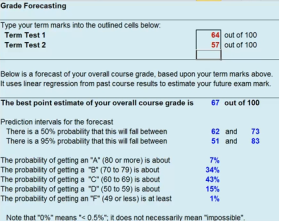“Optimism is generally a good thing, but it can sometimes interfere with learning,” states Dr. Michael J. Armstrong in his submission to Teaching Professor, February 2015, in which he outlines his grade forecasting strategy for students.[i]
Dr. Armstrong, an associate professor in Brock University’s Goodman School of Business, provides students with an opportunity to predict their final course grade (using test scores early in term and linear regression). This process addresses students’ tendency to be “overly optimistic about their learning process and anticipated course grades,”[ii] encourages a proactive approach (to increase study times or seek support, if needed) and, ideally, improves students’ ability to forecast and self-assess.
Optimism . . .
“can hinder their academic success. There’s no reason to adjust their behavior (say, by studying more) if they believe they are already doing well.”
Dr. Michael J Armstrong, Associate Professor
Goodman School of Business, Brock University
As a student support provider, I am interested in Armstrong’s strategy as well as his research showing that “weaker students [are] more likely to overestimate how well they are doing in the course”.[iv] Armstrong’s survey results present an interesting picture of student motivation and behaviour and invite further study:
“As for the impact of these grade forecasts, 31 percent of the respondents said the forecasting experience made them feel more positive or confident about their course progress, while 35 percent said they felt more negative or worried. Fifty-six percent said their motivation had increased, while 7 percent said it had decreased. Forty-seven percent said they were subsequently studying more than they had previously planned, while 3 percent said they were studying less.”[v]
These findings illustrate the complexity behind student behaviour. Discovering that they may get a lower grade than expected doesn’t always motivate students to be proactive (e.g., to study more). However, one student commented that “after seeing his forecast, he worked harder to “beat the number,” and was very pleased when he did.”[vi]
Above is a screen shot of the spreadsheet available to students to forecast their grade. Students fill in their term marks (in red) and the forecast is calculated automatically. My initial reactions to the tool? It’s easy to use and understand. Honestly, I was excited. However, I was also a little shocked and remember saying, “Well, that’s blunt.”
I’ve been thinking about students reactions to the tool: how some are motivated to “beat” the score and how some become anxious or less motivated. I believe that this response relates to students’ confidence and sense of agency. Students with low self-confidence and sense of control may accept the grade as a “done deal,” much like someone might read and accept their horoscope. Other students with higher self-confidence and sense of control may accept their “reading” as a challenge and take steps to improve. Why? . . . perhaps because they believe that they can “do something about it”.
This snapshot of student behaviour relates to my previous blog, 6 Reasons for Student “Apathy,” in which I explore the reasons why many students don’t take advantage of student support services.
Reason #3
Self-Concept and Confidence: Students often make closed statements about their “abilities”, saying “This is how I write” or “I can’t do math” or “I am a 60s student”. If I don’t believe that I can do better, why would I assess and revise my current strategies? Why would I invest more time and energy?
During an academic-zone.com webinar last month, Tricia from Conestoga College added to my list of reasons why students aren’t taking advantage of what’s available: because students often don’t know what they don’t know.
So, is the forecasting tool harmful? Will many students crawl back into bed and say why bother?
Overall, I feel that the tool is a fantastic resource to increase students’ awareness—a necessary step for students to become more empowered in the learning process. I also feel that providing students with strategies to improve and information on available services is key. Online resources work well because they can be available at that “Oh oh, I’m in trouble” moment. This was definitely a consideration when our Learning Services team developed Academic-Zone modules to complement our in-person support and offer on-line support 24/7/365.
I’m also thinking about student control.
I know the challenge of helping struggling students realize that they have the power to change their behaviour and, consequently, their future. One-on-one, I help students reflect on their past and help them see the role of their choices and actions in the process. I have witnessed their surprise and, as a result, their excitement and motivation to persist. Is there a way to facilitate this reflective process with the forecasting tool?
I wonder . . .
For more information on Armstrong’s work:
YouTube video describing the application of grade forecasting in a course
YouTube video describing the results of the research study
 Margaret Groombridge, MEd, BEd, BA, OCT
Margaret Groombridge, MEd, BEd, BA, OCT
Lead Designer, Academic-Zone
Coordinator Learning Skills Instruction
A-Z Learning Services, Brock University
[i] Armstrong, M. J. (2015). A grade forecasting strategy for students. Faculty Focus. Retrieved from http://www.facultyfocus.com/articles/educational-assessment/grade-forecasting-strategy/
[ii] ibid
[iii] ibid
[iv] ibid
[v] ibid
[vi] Armstrong, M. J. (2013). A preliminary study of grade forecasting by students. Decision Sciences Journal of Innovative Education, 11(2), 205. doi:10.1111/dsji.12003

